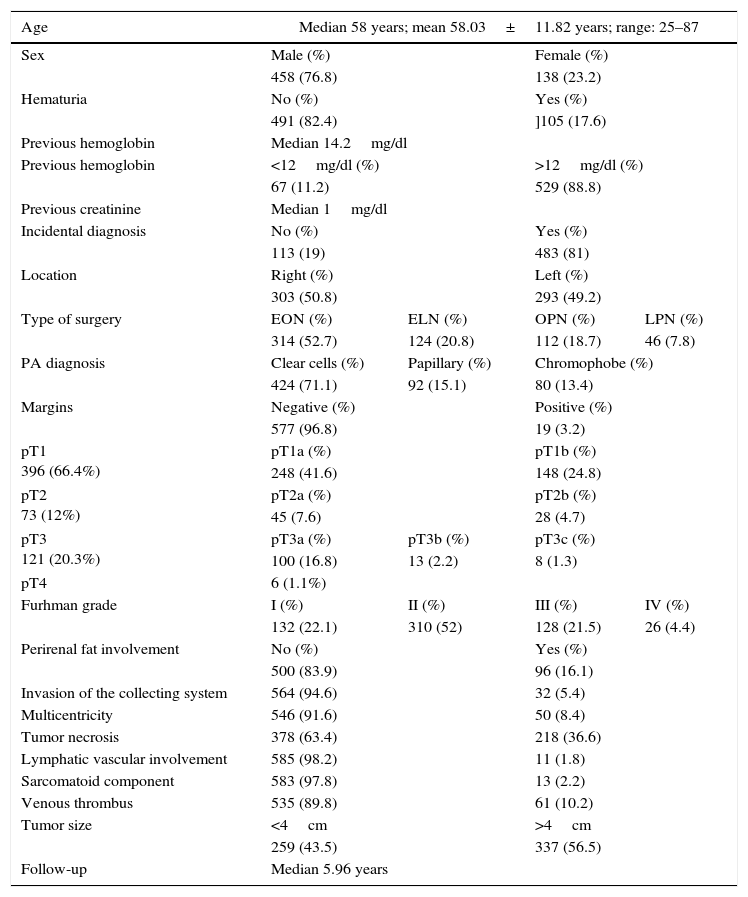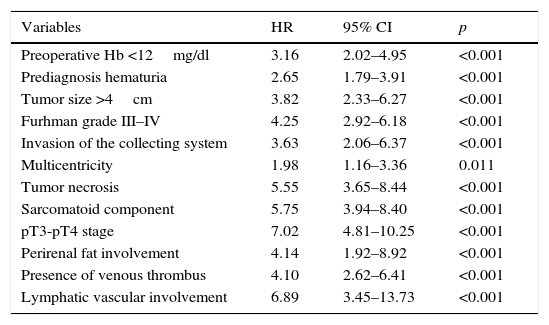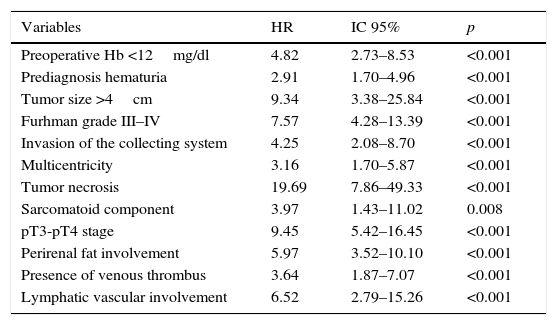We conducted a retrospective analysis of our series to assess the factors that influenced disease-free survival (DFS) and cancer-specific survival (CSS) for patients with localized renal cell carcinoma (RCC). We also created our own risk groups.
Material and methodsBetween January 1990 and December 2012, 596 patients underwent surgery for localized RCC (clear cell, papillary or chromophobe). Using Cox regression models, we analyzed the clinical-pathological variables that influenced DFS and CSS and designed risk groups for DFS and CSS with the variables.
ResultsThe median follow-up for the series was 5.96 years. By the end of the study, 112 patients (18.8%) had a recurrence of the disease, with DFS rates of 82%, 77% and 72% at 5, 10 and 15 years, respectively. The independent factors that influenced DFS in the multivariate study were the following: A Furhman grade of 3–4, haematuria, lymphocytic or vascular invasion, the presence of tumor necrosis and a disease stage pT3-pT4. Furthermore, by the end of the study, 57 patients (9.6%) died due to renal cancer, with CSS rates of 92%, 86% and 83% at 5, 10 and 15 years, respectively. The independent factors that influenced CSS in the multivariate study were the following: A Furhman grade of 3–4, perinephric fat invasion and the presence of tumor necrosis.
ConclusionsFactors in addition to the disease stage pT3-pT4 in patients with localized RCC are important, such as the presence of haematuria and lymphocytic or vascular invasion for DFS. A Furhman grade of 3–4 and the presence of tumor necrosis are especially relevant for DFS and CSS.
Realizamos un análisis retrospectivo de nuestra serie para evaluar los factores influyentes en la supervivencia libre de enfermedad (SLE) y en la supervivencia cáncer-específica (SCE) en pacientes con carcinoma de células renales (CCR) localizado y realizamos unos grupos de riesgo propios.
Material y métodosEntre enero de 1990 y diciembre de 2012 fueron operados 596 pacientes con CCR localizado (tanto de células claras como papilares o cromófobos). Se analizan las variables clinicopatológicas influyentes en la SLE y en la SCE mediante modelos de regresión de Cox y con ellas se diseñan grupos de riesgo de SLE y de SCE.
ResultadosLa mediana de seguimiento de la serie es de 5,96 años. Al final del estudio 112 pacientes (18,8%) evidenciaron recidiva de la enfermedad, siendo la SLE del 82%, 77% y 72% a 5, 10 y 15 años respectivamente. Los factores de influencia independiente en la SLE en el estudio multivariado fueron: grado de Furhman III-IV, hematuria, afectación vascular linfática, la presencia de necrosis tumoral y el estadio patológico pT3-pT4. Por otro lado, al final del estudio 57 pacientes (9,6%) fallecieron a causa del cáncer renal, siendo la SCE del 92%, 86% y 83% a 5, 10 y 15 años respectivamente. Los factores de influencia independiente en la SCE en el estudio multivariado fueron: Grado de Furhman III-IV, afectación de la grasa perirrenal y la presencia de necrosis tumoral.
ConclusionesAdemás del estadio patológico pT3-pT4 en pacientes con CCR localizado son importantes otros factores, como la presencia de hematuria y la afectación vascular linfática para la SLE; y especialmente relevantes el grado de Furhman III-IV y la presencia de necrosis tumoral tanto para la SLE como para la SCE.

















